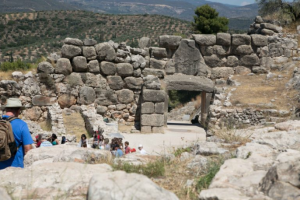A new study conducted by the Navarino Environmental Observatory (NEO), a research partnership between Stockholm University, the Academy of Athens and TEMES SA reveals that the end of the Mycenaeans, the civilization dominating western Peloponnese in the Late Bronze Age was most likely brought on by an extensive drought.
Researchers Martin Finne and Karin Holmgren, alongside archaeologist Shari Stocker following the analysis of a stalactite from a cave on the islet of Schiza, found that when the palace was destroyed it had already gone through a 20 year long dry period between 1200 and 1180 BC.
The morphology of the layers of the cave stalactite provided a clear picture about the climatic conditions in the eastern Mediterranean at the time with great accuracy.
While NEO agrees that Mycenae suffered from 20 to 80 years of droughts before Pylos saw its demise, the team argues that lack of water was only a “critical component”, not the sole reason for the loss of the civilization.
“Evidently the centralized administrative system controlled by the palace could survive a relatively short-term dry period and remain in control. Some 50 years later, however, when the pronounced period of aridity started to develop, the system would crumble,” the paper states explaining that the climatic conditions made it hard “for social elites to re-form and for the palatial system to be re-established.”
“The period of drought around 3,200 years [ago] could have contributed to the destabilization of the political and economic order. Increased aridity could have led to reduced agricultural output affecting the finely tuned economic system of a society that was close to, or already, overextended, rattling the very foundations of the fragile palatial economy.”
Source: neoskosmos
Ask me anything
Explore related questions






